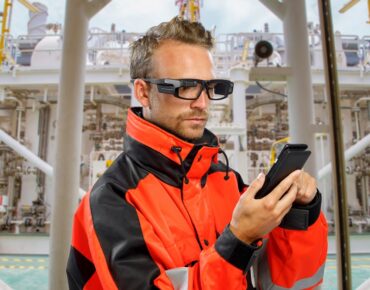From Smart Glasses to TikTok-style Training: How Manufacturers are Bridging the Knowledge Gap

In March 2020, during the first month of the pandemic, a sterilization machine manufacturer shipped a large piece of equipment to Italy to help process tomatoes ahead of the spring harvest. They faced a potential problem, however.
Normally, the manufacturer would have sent a company representative to help the farmer get the machine up and running. Because of the travel restrictions, though, no one could travel to provide help in person. Meanwhile, the May tomato harvest was fast approaching. How could workers learn how to use the new machine when trainers were stuck elsewhere?
Luckily, an innovative and easy solution was available. Because the manufacturer used an instructional platform and wearable smart glasses, the company’s knowledge was portable, even though the employees were not. The manufacturer sent a couple of pairs of glasses to the farmer. The manufacturer’s specialists were then able to walk the farmer through setting up and running the equipment – remotely.
Knowledge Portability
The portability of knowledge has been a major theme in global business as countries rescind and reinstate pandemic travel restrictions and other instability fluctuates. Supply chain snarls in particular have led many companies to reconsider large-scale operations overseas. More and more companies in the US and Europe are moving operations home or at least closer to their domestic markets, a trend that industry experts are calling reshoring or nearshoring.
With that trend comes a knowledge vacuum in the new operations, however. The most senior workers who possess deep, invaluable – and often undocumented – institutional knowledge of operations don’t always move to new facilities.
No more heavy binders
The headaches associated with training new employees are nothing new, of course. Traditionally, companies have relied on training videos and programs in addition to heavy binders of dusty tech manuals to introduce workers to their responsibilities. But the training lessons can be quickly forgotten, and the tech manuals usually sit untouched in the shop floor office.
Most jobs operate on the 80/20 principle – 80 percent of the workflow never changes and can be broken down into step-by-step procedures, while the other 20 percent require advanced skill and expertise. That’s why junior-level workers, even if they study the manuals closely, still need senior mentors standing behind them, providing real-time instructions, encouragement, and constructive criticism. Without experienced workers affording institutional knowledge of the workflow and the operation, consistency can suffer and human error is more likely.
But 20-year veteran workers are scarce, the old hands who know the assets and everything about the job. They are less liable to move when a company opts to reshore or nearshore operations, too. Companies who can’t relocate these workers often discover very quickly that relocating operations isn’t so much a matter of moving activities. It’s relocating knowledge.
Fortunately, tools like smart glasses, iPads, smart phones and supporting platforms and software can be easily integrated into a manufacturer’s production line – providing uniform instructions for 80 percent of the job as well as personalized, expert oversight and feedback for the remainder.
Taking advantage of the TikTok revolution
Companies that embrace technology are capitalizing on the reality of the modern worker who gets their information from ever-present social media platforms like TikTok, YouTube, and Instagram. Modern employees are used to learning how to bake sourdough bread or a new dance move from short videos on those platforms. Smart tools and the omnipresent smart phone are second nature to them.
It’s the same concept on the shop floor thanks to connected worker technology. The technology brings in audio and visual guidance and the ability to talk to colleagues (i.e., remote assistance) while performing tasks. Ten-second videos can explain a single task in a multi-step process, providing an efficient and effective way to train new workers without the senior workers looking over their shoulders. Employees are instructed to photograph their work with their wearable technology, which sends the images back to a central point for quality control.
Quality Control
If workers are struggling with a task, they can receive real-time remote assistance on how to perform it properly. At the same time, workers know that they will be held accountable because they can access resources to complete their tasks.
The system is scalable too. Your experts in a central location can field questions and troubleshoot for multiple locations, putting out fires as soon as they flare up. Importantly, these systems can also automatically track worker progress and nudge when they’ve fallen behind or completed a task too fast for it to have been done properly.
Another major advantage of a connected worker platform is that all steps of a quality inspection are automatically logged. The worker who performed the inspection no longer needs to do the paperwork afterwards – a task many technical operators are not too keen on.
The two-way communication allows workers to tell controllers when they are having trouble. The platform also collects and analyzes that data so that processes can be constantly adjusted and updated based on worker comments. The result is often more engagement and motivation as workers help shape the workflow.
Labor Shortage
Manufacturers are struggling to replace the 1.4 million workers who have left their jobs since the start of the pandemic, according to the U.S. Chamber of Commerce. They expect 2.1 million manufacturing jobs to remain unfilled through 2030, the National Association of Manufacturers found. Demand is increasing, however. Work still needs to be done and assets are becoming more and more complex to maintain.
Wearable technology, with the right digital support platform, will enable companies to centralize knowledge, save money, and ensure quality work despite labor shortages. Like the Italian spring tomato harvest, the time is ripe to embrace smart devices likes glasses and phones and supporting software to streamline production and prevent disruptions to business.
Peter Verstraeten is Chief Executive Officer of Proceedix, a SymphonyAI Industrial company.











